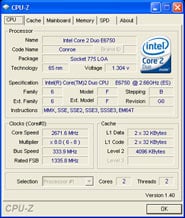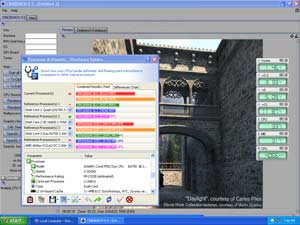Vital Signs and Overclocking
As you probably expect, the Core 2 Duo E6750 looks just like any other Core 2 Duo CPU thanks to the processor's integrated heat spreader. But the underside too looks just like the first batch of Conroe-based processors that hit the market last year.
The Core 2 Duo E6750 uses Intel's LGA775 (Land Grid Array) packaging, just like all of Intel's desktop processors for the past three years, and while built using Intel's 65nm manufacturing process, underneath that IHS lies a new revision of the Conroe core.


Core 2 Duo E6750 CPU-Z Information
As you can see in the CPU-Z screenshots above, this particular processors has a core clock speed of 2.6GHz, with a default multiplier of 8 and an actual front side bus frequency of 333MHz (1333MHz quad-pumped). This is particularly important because Intel's previous generation of chipsets do not officially support an FSB frequency that high, even though most of them are capable of running in that range through overclocking. With this new line of processors, Intel is hoping to speed up the adoption of their new P3x and G3x desktop chipsets
Also of note according to CPU-Z are the new E6750's revision and stepping. The version of Conroe at the heart of the E6750 is stepping B revision G0. If you recall, the first Conroe-based processors to hit the market had a stepping of 5 and a revision code of B1. We asked for details on what specifically had been changed in the new stepping / revision, but have not gotten an answer just yet. If Intel discloses the changes, we'll be sure to update the article and let you know.

Core 2 Duo E6750 Overclocked to Almost 4GHz
As is typically the case, we like to overclock every new processor to land in the lab to see just how much clock speed headroom it has. In our initial look at Conroe, we were able to take a Core 2 Extreme X6800 processor up to about 3.5GHz using nothing but a slight bump in voltage and the stock air cooler, which is nothing to scoff at.
This time around, however, our results were nothing short of spectacular. By bumping the processor's core voltage to 1.45v and increasing the front side bus speed via our Asus P5K Deluxe motherboard's BIOS, we were able to take the Core 2 Duo E6750 up from its default clock speed of 2.6GHz to an impressive 3.92GHz (multiplier=8x / Front Side Bus Frequency=490MHz. This was done using the stock Intel CPU cooler on an open-air test bench. At that speed, the CPU completed a Cinebench rendering pass in just 18 seconds and it blew past the Core 2 Extreme X6800 in SANDRA's Processor Arithmetic benchmark.
We should also note that throughout all of our overclocking experiments, the CPU barely hit 48°C and it seemed to heat up and cool down very quickly. We've only spent a limited amount of time with this chip and haven't experimented with multiple motherboards just yet, so we're not certain these temperature readings are accurate, but this early data suggests that this new revision of Conroe runs quite cool and has excellent overclocking potential.








